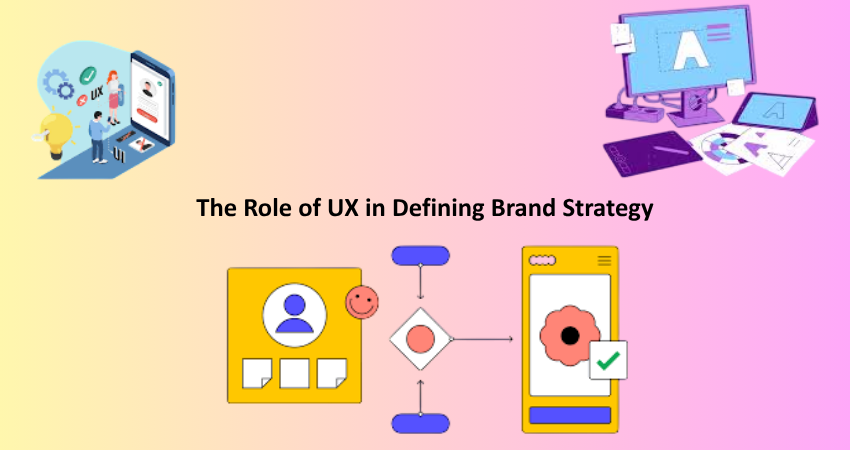
Introduction
In the current times of cut-throat digital competition, a brand cannot be defined anymore by just its logo or marketing campaigns. The experience of the user, starting from the entering of the website and opening of the app, is a major shaper of the perception of the brand. This is where UX and UI come into play- the two fields synergize to constitute the foundation of digital branding. The way they perceive your brand will be defined by how seamless, intuitive, and beautiful that home page, product catalog, and ultimately transaction appears to them.
As it is in the modern era of technology, first impressions make up in this virtual world. Even after a user has a great product or service, if they encounter navigation issues, long wait times, or an awkward interface, there is virtually no chance that they will return. Alternatively, however, a seamlessly functioning, beautiful, and user-centered interface fosters trust and loyalty. UX/UI is much larger than aesthetics and usability in isolation since it is about creating the entire brand experience. It means that interactions, functionality, and design elements should all reinforce one another with the core identity and values of your business. When UX/UI is treated as a strategic asset, it becomes a driving force in building digital brand equity, differentiating your business, and driving customer engagement.
Why UX/UI is Crucial to Modern Branding
Enhancing Brand Perception through Design
In most cases, the website or app is the first interaction between your brand and a potential client. Different from the tactile nature of classic branding — one of brochures and catalogs — modern branding has predominantly become digital, with UX/UI being the backbone of how these experiences unfold. When users engage with your digital platform, they unconsciously assess your brand’s professionalism, reliability, and uniqueness. A clean, responsive, and attractive UI builds trust, whereas an interface that’s jumbled or antiquated does the opposite. Everything visual — be it the typography, colors, button shapes, or animation — communicates your identity and value proposition.
Additionally, it’s the UX aspect that makes sure that the design is beautifully appealing as well as useful. UX aims to align the needs of the user with the objectives of the brand by allowing the user to accomplish their objectives efficiently and intuitively. This not only improves usability; it also gives the user a positive emotional experience with the brand. Fast-paced modern times require convenience, swiftness, and clarity from the user’s point of view. If the user interface and user experience of a given brand fail to provide it, users will swiftly switch to a competitor. That is why investing in quality design becomes an import-unbearable requirement toward erecting a positive brand perception in a virtual space.
Driving Customer Trust and Loyalty
Consistency in the user experience creates familiarity and trust. Control will be given to users when they know what to expect on your digital interface. A pivotal aspect of branding, this consistency strengthens your visual identity, tone of voice, and reliability. A thoughtfully created interface suggests that the brand cares about the details and the flow of the user’s experience. It adds to the user’s trust with every granular interaction: a confirmation message once they have successfully submitted a form, an error message along with a helpful tip on how to fix the issue, and so on.
Trust is built when users are repeatedly satisfied and have seamless experiences for the longer term. The emotional response generated by UX/UI design transforms attitudes and behavior, hence decision-making processes. In contrast, if customers feel valued, understood, and in control of their digital interaction, they’ll be more likely to keep coming back. Retention becomes a focus in e-commerce and SaaS, thus maintaining loyalty. A great user interface eases user interactions while compelling user experience strategies minimize dropouts and foster conversions. Trust is branding currency; XUX/UI design is the brand’s digital earner.
The Role of UX in Defining Brand Strategy

User-Centered Design as a Branding Tool
This is the very basis of user-centered design, UCD, making the user the center of every single design decision, the center of all understanding of rich resources in studying user behavior, preferences, and challenges, understanding those needs, and finally building solutions that meet those needs. UCD usually involves research, personas, usability testing, and feedback loops. With this knowledge at hand, a brand is then able to completely personalize experiences. That personalization continues to make the experiences relevant as well as intuitive. This human aspect not only maximizes users’ usability but also creates an emotional tie that is so deep with the user and the brand.
Finally, the best resource is about perception – how people feel about your business. UX decides how that perception is actually built. Each interaction that a product or service has with a person has to be meaningful and pleasant, and then gives that worthwhile association which exemplifies the customers in a manner that exemplifies the brand’s core values and differentiators. Either you position your brand as cutting-edge, innovative, or rather simple and customer-first; but UX really grounds that to design patterns and workflows. This is deeper than form-follows-touch. It does not require something that works; it requires something that has a reason for being and resonates with people on a deeper level.
Emotional Impact and Storytelling Through UX
Indeed, emotions impact people’s perceptions of brands, and UX design exploits these by creating experiences that elicit emotions ranging from joy, and satisfaction, to security and trust. Such elements of interaction could be fun animations, sounds, and feedback that surprise and delight users or reassure them through critical moments, such as completing a purchase. These emotional stimuli will shape brand storytelling and make users feel within the fold of something much larger.
A good user experience narrates a story with the user as the protagonist: each screen, each action associated with it, and each design element further fleshes out the story. The way in which the brand guides users with obvious flows and rewarding interactions causes this to be an ally based on trust. Emotional design does not mean overly embellished or gimmickry; rather, it is being intentional in experience design and creating real feelings aligned to brand messaging. A strong emotional bond is what makes it possible for engagement as well as possible word-of-mouth-turned-loyalty-the making of users all the way to ambassadors for the brand.
The Visual Identity Connection in UI Design
Translating Brand Aesthetics into Interfaces
UI design interprets a brand’s visual language for use in digital interfaces. Everything from colors and types to buttons and icons must speak to the brand’s identity and values. For instance, the fintech app may fleece blue tones that convey trust and stability; a wellness brand might employ earthy tones with rounded edges to conjure calmness and approachability. This visual language creates an immediate sense of familiarity that allows users to identify and engage with the brand quickly.
A robust UI strategy implies a consistent design across websites, mobile apps, email templates, and other potential assets, even the ones offline. Such brand uniformity creates recall, which gives the user confidence in your product. The design guide, component libraries, and style guidelines ensure that your visual identity is consistent across every customer interaction. The UI does not merely follow; it plays a crucial branding role in helping shape perceptions, communicate intent, and tell users what they should expect even before they engage.
Aligning UI Consistency Across Channels
The essence of brand consistency across different platforms lies in trust and recognition. Whenever the user visits the desktop site or browses through the mobile app and through the smart device, the branding should feel unmistakably “you.” UI design keeps visual and interactive patterns coherent across channels while maintaining this multi-channel consistency not just for aesthetic purposes but also to reduce the cognitive load on users. Familiar navigation, repetitive motifs for design, and standard symbols make for predictable experiences that count for usability and customer satisfaction.
For every company operating in the digital spectrum-social media, web apps, mobile, and desktop-much more is going to depend on how well the UI design is going to scale. This is where designing systems like Google’s Material Design or Apple’s Human Interface Guidelines become important. Thus, ensuring good scalability and consistency reinforces brand identity. UI design is the visual handshake between a brand and its users; when that handshake feels different every time, users stumble at connecting with the brand. When companies use an integrated UI approach, they can tell the same story of the brand across every screen.
UX/UI Impact on Conversion and Business Metrics

Designing for Engagement and Conversion
Good UX/UI adds that little bit more to the performance of any aesthetic: it enhances one’s bottom line. Not directly indeed, but design affects user behavior, especially conversion rates. A good flow from point to point, ready-at-hand call-to-action buttons, well-configured forms, and all mobile-friendly functions contribute to the way users don’t bounce but stay to engage the site. The easier browsing, deciding, and acting makes it for the users, the more likely it is that they will buy something, subscribe to newsletters, or request a demo-all good things in business.
UX/UI even has a role in reducing customer acquisition cost (CAC). When making the digital landscape easy and inviting, users will tend to come on board by themselves with little to know if any paid advertisement. So with a great experience towards the user, they will be stickier and leave them less; thereby using the most of what they will be making as lifetime value (LTV). Sometimes, small changes made by design, like having an optimized checkout page or improvement in flows through which users are inducted, can bring significant change in stats concerned with conversion and satisfaction. That is, by design; it is no more a cost center but a growth engine.
Measuring the ROI of UX/UI Investment
Investments in UX/UI design return measurable results, and measurements like task completion rates, time spent on a page, conversion rates, and net promoter scores all give insight into user interactions with your digital avenues. At this point, using tools like Google Analytics and Hotjar and such usability tests can track behavior in real time to help identify friction behavior in UX. Informed improvements to the design can produce measurable business results.
Plus, companies that invest in UX/UI likewise reap increased customer satisfaction, decreased support calls, and increased customer retention. In the long term, these benefits break down into lower operating costs and increased competitiveness in the marketplace. Once UX/UI is treated as a strategic business function against being a design issue, companies have the ability to improve the user journey for the sake of long-term brand success. From the startups to the enterprises, businesses that employ UX/UI design outperform those that do not. The proof lies in the data, not just the experience.
Conclusion
UX/UI now underpins the entire architecture of digital branding; it decides how users will understand your brand, how they will use your digital products, and whether they will return. Perfected UX and UI are so expertly designed that they can touch every aspect of a customer’s journey, beginning with that moment when a user first encounters a brand. The experience is prolonged; it shapes impressions and evokes emotion, converts, and finally retains, controls, and builds loyalty. When well-strategized into the brand strategy, they create memorable digital touch points whose resonance lingers long after the contact.
In today’s world, where time and space turn attention into real estate, places to disrupt competition in digital worlds, such as UX/UI design, offer a sustainable competitive advantage. It connects businesses to people, technology to emotions, and functionality to beauty. And when such brands recognize the value of experience-driven design, there is no way they will be limited in any way-they will thrive. So the next time you are preparing to release a fresh digital product or re-launch an existing platform with a makeover, keep in mind: your UX/UI is your brand’s digital handshake. Make it count.